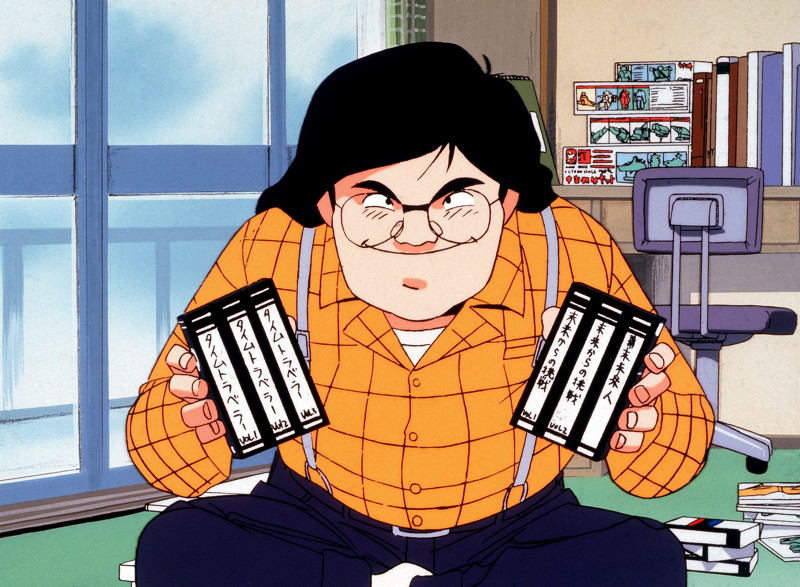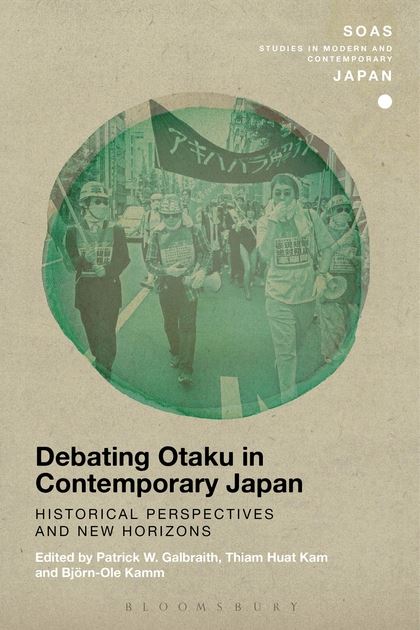Books: Debating Otaku
September 9, 2018 · 1 comment
By Jonathan Clements.
 Debating Otaku in Contemporary Japan: Historical Perspectives and New Horizons will prove to be a vital core text in understanding the history of anime and manga fandom. This is not merely for its incisive analysis of the transformations of the word otaku over the last thirty years, but also for its detailed accounts of incidents that are otherwise mentioned as mere asides in other works. Two of the book’s ten chapters comprise translations from the works of self-styled “Otaking” Toshio Okada, and many other sections contain useful primary source material.
Debating Otaku in Contemporary Japan: Historical Perspectives and New Horizons will prove to be a vital core text in understanding the history of anime and manga fandom. This is not merely for its incisive analysis of the transformations of the word otaku over the last thirty years, but also for its detailed accounts of incidents that are otherwise mentioned as mere asides in other works. Two of the book’s ten chapters comprise translations from the works of self-styled “Otaking” Toshio Okada, and many other sections contain useful primary source material.
Not everybody is happy about this. Eiji Otsuka, a man complicit in the coinage and dissemination of the term otaku in the first place, is furious that it has become such a thing, and regards the attention of researchers and the vainglorious bragging of the Japanese government as an air-brushing of history, cutting Japan off from its connections (good and bad) to East Asia, and turning it into a harmless, fanboy collector in the American orbit. He is so angry, in fact, that his foreword to this book comes with a prolonged translator’s note pleading mitigation and indulgence, like some apologetic youth dragging a drunken uncle away from a bar fight.
 Otsuka’s introduction claims that much of the way modern Japanese popular culture is perceived is the result of a “cultural revolution” in which the failed student rebels of the 1960s, defeated in the battle for the media, sulkily turned to its dregs as the last place they could not be thrown out of: cartoons, porn and kids’ shows. He compares the likes of Yoshiyuki Tomino working on Gundam to the same sublimation and suppression of political passions found among the draftees who worked on wartime propaganda.
Otsuka’s introduction claims that much of the way modern Japanese popular culture is perceived is the result of a “cultural revolution” in which the failed student rebels of the 1960s, defeated in the battle for the media, sulkily turned to its dregs as the last place they could not be thrown out of: cartoons, porn and kids’ shows. He compares the likes of Yoshiyuki Tomino working on Gundam to the same sublimation and suppression of political passions found among the draftees who worked on wartime propaganda.
Otsuka’s piece is tough going – frankly, it drops so many allusions and requires so many clarifications that you need to speak Japanese to fully understand it, even in English. But crikey, it’s a work of bridge-burning effulgence, digging down to the original 1983 article in Manga Burikko magazine that first alluded to “otaku” culture, and restating Otsuka’s own editorial objections to what, even then, he regarded as snobbish and discriminatory language. He derides post-modernism and cultural studies, the foundations of the work of many of the other authors in the volume, as a pretentious joke at academia’s expense, and ends up suggesting that almost everything written about anime and manga in the last twenty years has been a futile juggling act by clueless observers who couldn’t see they’d been cheated.
After a mic-drop like that, the editors are on hand to drag the conversation out of the garbage fire, placing Otsuka’s own remarks in historical context, and to gently indicate, through quotes from dissenters like Thomas LaMarre, Sharon Kinsella and Gayle Rubin, the possibility that he has a point, and that much of what is written about otaku in academia amounts to solipsistic wittering about one’s own hobbies, and well-meaning but condescending orientalism. “We welcome the internal tensions in the discussion of ‘otaku’,” they write, “which we hope will open into debates about what each of the contributors is talking about and why it matters.” So, no pressure…
Patrick W. Galbraith revisits the original Manga Burikko article by Akio Nakamori, noting that its original intention was to ridicule fanboy losers who were obsessed with cartoon characters. He, like many other writers in this volume, is determined to emphasise how even at the beginning, otaku didn’t necessarily mean what people thought it meant, and outlines its growth out of the Lolicon movement of the 1970s. He concentrates specifically in the discussion of otaku as “failed men” – in other words, early discussion of the term neither allowed for the proud reclamation of the term as a badge of honour, nor even for the presence of female otaku. Tomomi Yamanaka, meanwhile, quotes extensively from the original piece, noting that it was nicely inclusive of women, too, in the sense that they were just as derided as the men:
“You know, every class has one of those people who can’t do sports, is withdrawn in the classroom, even during breaks… They’re like that… The boys are either skin and bones – borderline malnourished – or squealing pale-faced piggies… All the girls sported bobbed hair and were mostly fat, having tubby legs covered in white high-socks.”
She is also quick to point out how swiftly the readership of the same magazine called out Nakamori’s sneering. “If I may,” read one reader’s letter, “your essay is something like pointing out handicapped people, saying they are an unpleasant presence, and proudly calling yourself a normal person.” Nakamori’s column, intended as an ongoing series, was cancelled after three instalments, seemingly because of the ire it provoked among its own readers. Yamanaka goes the extra mile, sifting through editor Otsuka’s own comments in subsequent years, not only on the column itself, but on the reasons for its cancellation and its true impact – it was not reviled entirely, but certainly divisive.
 Björn Ole-Kamm moves forward to the end of the 1980s, when the arrest of child-murderer Tsutomu Miyazaki suddenly caused the term otaku to take on a far more sinister meaning in the media. Or did it? By excavating through publishing dates and materials, he argues that much of the 1990s publishing on the otaku phenomenon, including Toshio Okada’s Introduction to Otakuology, were intended to correct a trending sense that liking anime and manga was a bad thing, by re-appropriating the word otaku to mean “fan”. Along with a translator’s note that restates its context as “intervention” in a larger argument, we even have long excerpts from Okada’s book and his later Otaku are Already Dead, presented as separate chapters, and immensely valuable to researchers who cannot read Japanese. Okada’s earlier book, and the Gainax anime Otaku no Video that first introduced the term to many overseas anime fans, are covered in a chapter by Lien Fan Shen.
Björn Ole-Kamm moves forward to the end of the 1980s, when the arrest of child-murderer Tsutomu Miyazaki suddenly caused the term otaku to take on a far more sinister meaning in the media. Or did it? By excavating through publishing dates and materials, he argues that much of the 1990s publishing on the otaku phenomenon, including Toshio Okada’s Introduction to Otakuology, were intended to correct a trending sense that liking anime and manga was a bad thing, by re-appropriating the word otaku to mean “fan”. Along with a translator’s note that restates its context as “intervention” in a larger argument, we even have long excerpts from Okada’s book and his later Otaku are Already Dead, presented as separate chapters, and immensely valuable to researchers who cannot read Japanese. Okada’s earlier book, and the Gainax anime Otaku no Video that first introduced the term to many overseas anime fans, are covered in a chapter by Lien Fan Shen.
Other authors take the phenomenon into the 21st century, an age of narrow-casting, niche audiences and technological disruption in which some of the original otaku found themselves not “losers” at all, but media magnates and newly minted experts on consumer culture. Satoru Kikuchi examines how this has transformed entire districts of Tokyo, such as the fanboy paradise of Akihabara (the girls’ version, before you call me a sexist, is less well-known in Ikebukuro). In particular, he notes the sea-change brought about by Neon Genesis Evangelion, a fan-centred anime that broke out so far into the mainstream that otaku stopped being such a bad word after all. In a similar vein, Alisa Freedman discusses the impact and context of Train Man, in which an otaku figure became a heroic, romantic protagonist.
There’s quite a lot in here that Fan Studies people will find shocking. It presents a view of the Japanese media far removed from that of, say, Alexander Zahlten’s The End of Japanese Cinema, which suggests that it was the mainstream that failed, and that the “revolution” in Japanese popular culture was over when the fans took over, or indeed, Steinberg and Zahlten’s Media Theory in Japan, which argued that Japanese cultural theory has been a matter of impressive local development. It’s not that the books necessarily contradict each other – they all perform their tasks well of continuing the discourse and debate, taking it further and deeper than the opening salvoes of The End of Cool Japan – but one is left with something of a timid silence at the dinner party, in the wake of Eiji Otsuka setting fire to himself and charging from the room like a comedy stuntman, shouting that it’s all pointless. For that reason in particular, this is a book that is sure to be much cited, mainly by researchers trying to argue with it.
Jonathan Clements is the author of Anime: A History. Debating Otaku in Contemporary Japan: Historical Perspectives and New Horizons, edited by Patrick W. Galbraith, Thiam Huat Kam and Björn-Ole Kamm, is published by Bloomsbury Academic.
PaulJ
September 13, 2018 8:48 am
Otaku: The elite of the losers? By their very nature they will never change the world, let alone their sweaty clothes. They are neither American cool or British punk. If they weren't obsessing over panties and big boobs ( or Bishi-boys) they'd be out spotting trains.